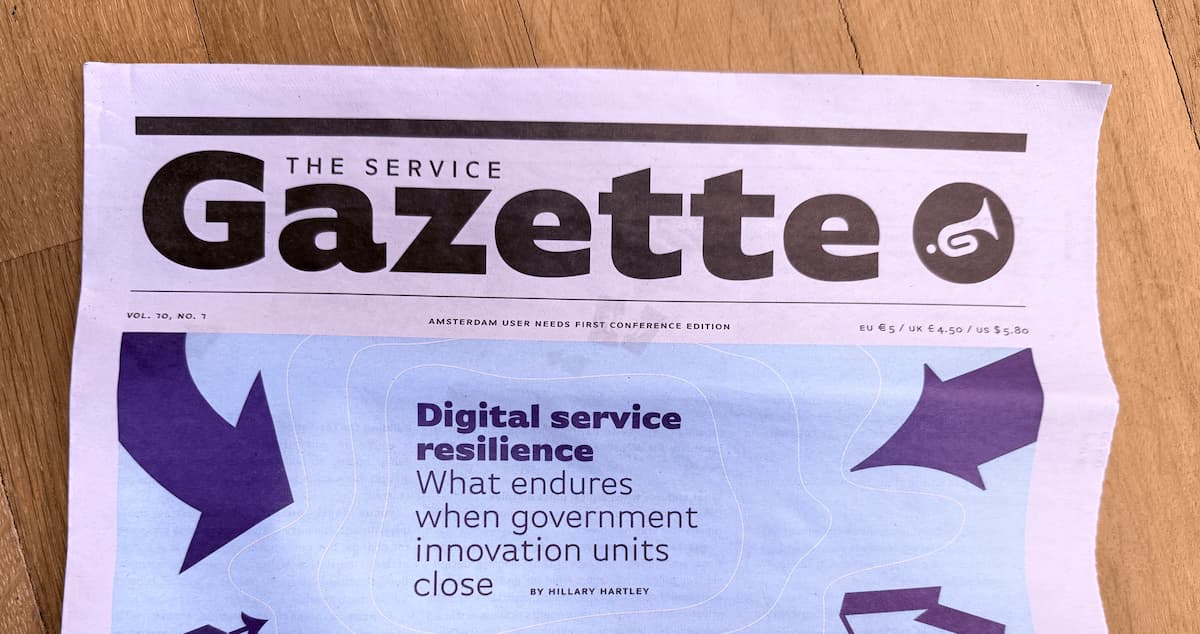Reading List
The future of government is green: five ways to make a sustainable difference today from hiddedevries.nl Blog RSS feed.
The future of government is green: five ways to make a sustainable difference today
Today, the ICT sector accounts for about 1–2% of global greenhouse gas emissions. That’s more than aviation, and the number is growing. These statistics may be unnerving, but they do mean that we can make a lot of impact at work.
I wrote this as an aricle for the latest edition of The Service Gazette, a newspaper that has been in print for 10 years now, collecting stories for and from over service innovators from more than 20 countries. Republished here with permission. Added links only.
 The Service Gazette
The Service Gazette
Individually, we can use trains instead of planes, hold on to stuff longer and switch to plant-based diets. These personal practices help reduce emissions. But what is our impact if we improve the sustainability of our products? For anyone who works on government services, there is a potential to reduce emissions at scale. Lots of people use our services, after all. And if your team is in one of the 195 countries that signed the 2015 Paris Agreement, your green efforts are aligned with policy.
The footprint of digital services is largely in three areas: energy used by data centres, energy used by networks and energy used by our users’ devices. My recommendations are based on reducing each pillar.
Be picky about hosting
“The cloud” might be merely a metaphor, but the data centres that host your services are real. Not all providers are green. It’s a start when they offset emissions. It’s better when they reduce them, by implementing efficiency measures. It’s best when they manage to avoid emissions altogether, for instance by building their own green energy supply (this is rare but it exists). Physical location of data centres, specifically proximity to renewable energy, can make a huge difference.
According to the HTTPArchive, around 15% of websites currently use green hosting. That means there is still a lot of room to improve. Find out if your hosting is green and plan to switch if not.
Make everything smaller
In 2011, the median page weight for desktop sites was 467 kB. It’s 2678 kB today. In those years, we’ve added magnitudes more images, more JavaScript, more videos and more fonts to our web pages.
It’s important to consider what we add to our pages. Text is lighter than images, images are lighter than videos. Your developers likely can and should ship less CSS and JavaScript. Set aside time for them to reduce existing bloat and agree on a budget. On websitecarbon.com, you can check your own site for size and more.
Ship only necessary features
Do you need that AI-powered widget, or can a well-written FAQ cover the same basic needs? Is it necessary to show all locations on a map, or does a simple list suffice? Must you experiment with the blockchain, or is an old-school database fine? There are significant differences between features in their need for data or computing power.
Be frugal about the amount and complexity of new features, and avoid the ones that are emission-heavy. ai-powered features deserve a special mention: Training and using large language models is magnitudes worse for the environment than building features without them. We can’t afford to just add LLMs to everything, we must weigh their utility against added emissions.
Support older devices
It’s estimated that 70–95% of emissions associated with personal devices is due to manufacturing and disposal, not their usage. This means that purchasing a new phone or laptop is by far the most “expensive” part in terms of climate impact. The longer a device is used instead of replaced, the better.
We can help with this when building digital services: by not being the one that makes users upgrade. Developers usually maintain a list of browsers and systems they support: make the case to add support for older devices. Make the ui smooth on old devices, too.
Demand sustainability from suppliers
If you work for a government service, you have power. Especially if you are involved with procurement or are friendly with the people who are. Ask questions about sustainability when procuring new products and services. Do they follow best practices, is there a plan for emissions reduction and is the necessity of data stored assessed regularly?
Conclusion
Above, we’ve looked at five different ways that people who work on digital services for the government can try and reduce emissions. You can look at hosting, file sizes, feature scoping, device support and the power you have to ask questions. Hopefully, these recommendations help you to build more sustainable digital services.
Originally posted as The future of government is green: five ways to make a sustainable difference today on Hidde's blog.